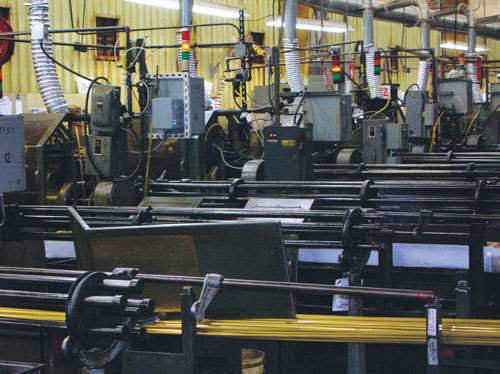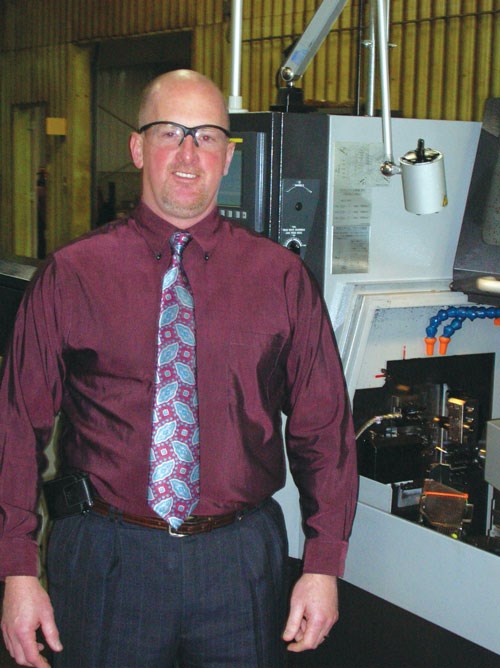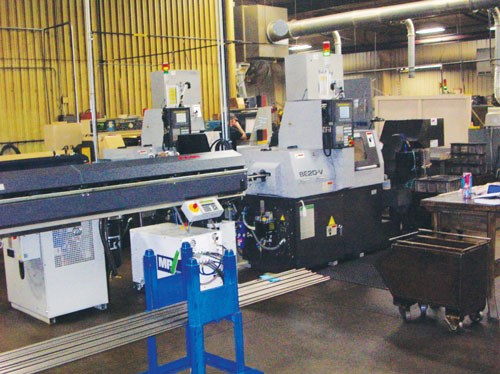Adding Swiss Machining to the Production Mix
In business since 1946, this Michigan shop has survived and thrived, and it is building up a CNC Swiss machining department to augment its banks of multi-spindle automatics.
Like many classic screw machine shops, Precision Metal Products Company has made a good living for its owners and employees for more than 65 years. Its stable of 14 1-inch Acmes and 26 Davenports up to 3/4 inch have been, and continue to be, the production backbone of this third generation shop. Mark Drooger, the company’s president, invited PM to visit his Holland, Mich., shop to see how the future is unfolding for this 30-person machine shop. The recent addition of CNC Swiss-type machining capability to the multi-spindle foundation has impacted the shop both internally and externally. Mr. Drooger’s business approach may well serve as a model for other shops on the cusp of transition.
Featured Content
Coming Back
Being a Michigan shop, the automotive industry is an important customer for Precision Metal. Mr. Drooger says 40 to 50 percent of his shop’s business is for that industry.
The balance of the shop’s customer base is spread across the furniture, rail, heavy equipment and appliance industries. Of course, these and other industries have been major participants in the off-shoring wave of the past few years.
“Since the middle of 2009, we saw the economy start to turn around,” Mr. Drooger says. “We started getting busier with work, some of which had been sent overseas. We saw some nice year over year increases from existing customers and new customers, many looking to source their parts closer to home. Most of our business is regional—Michigan, Ohio, Indiana and Illinois—so our ability to be responsive to those customers is a competitive advantage.”
Some of the reasons Precision Metal’s customers give for this sourcing change include rising prices in China and Asia, transportation costs being a big one along with quality issues and lead times because of distance. It seems to be a wave that is catching on. Mr. Drooger says he believes this reshoring trend will continue as companies look at the total cost of overseas manufacturing. “It may be cheaper up front to off-shore, but in the long run, many companies find that the cost savings often don’t pan out,” he says.
Can’t be Passive
Of course, the happy trend of reshoring is a result of more than just issues with overseas producers. U.S. manufacturers have had a wake-up call during the past decade, and the message has been to get more competitive.
Many shops have answered this call by making their businesses lean and more productive, basically learning to do more with less. Unfortunately, many of the traditional lower skilled jobs that factories traditionally provided have been supplanted, in many cases, by more productive processes and technologies. There are manufacturing jobs to be had, but the skills needed to get them are different today.
Those shops, like Precision Metal, that managed to survive the recession are seeing business rebound mostly because they have seen opportunities beyond their historic comfort zone. Moreover, they have made the decision to embark on investments that can take advantage of those opportunities.
From Cams to G-Code
In Precision Metal’s case, one of those forays out of its comfort zone involved getting into Swiss-type machining. As is often the case, it was a potential customer that helped force the issue, but Mr. Drooger was open to new ideas.
“We picked up a potential new customer who gave us a package of parts to quote,” Mr. Drooger recalls. “Originally I had it quoted that we would blank the parts on a Brown & Sharpe, and then do milling and drilling operations
as secondary operations. It was a pretty standard process for us.
“However, the package got too big to process as quoted (a nice problem to have), so I had one of my employees attend IMTS to look at alternatives,” Mr. Drooger says. “This was IMTS 2010. My employees brought prints of the parts we needed to make and visited various builders at the show. The consensus was the part would run well on a Swiss machine.”
Mr. Drooger’s employees made the rounds of the builders at the show and ended up soliciting time studies and quotes from three Swiss builders. Precision Metal ran the time studies by the customer and was able to win the entire package. “When it was all said and done, we decided to
go with Tsugami and purchased a model BE 20,” Mr. Drooger says.
According to Mr. Drooger, the closer for selecting a
CNC Swiss-type was the machine’s ability to perform all
of the operations necessary to make the volumes and variety of the part package in a single handling. The parts require some drilling, some tapping, a gear hopping operation on lead screw stock. The original quote required multiple operations and part handling while the Swiss-type machine could process the part complete and allow for unattended or lightly attended operations.
The CNC Swiss machines were not Precision Metal’s first CNC machine. Several years before purchasing the Tsugami, the company bought a Miyano CNC at an auction. However, lacking the infrastructure needed to program the machine it was not utilized fully.
“We never quite made the transition to CNC primarily because we lacked the skill sets needed to program and tool up the machine,” Mr. Drooger says. “We had trouble finding work for the machine to justify hiring a programmer; moreover, we had difficulty finding one. When we did get a CNC job we sub-contracted the work to other shops in the area.”
That all changed when the Swiss machine hit the floor. That investment rededicated Precision Metal to the idea of CNC and motivated them to find a programmer/operator to man the new department.
With addition of the new programmer/operator, extensive training from the local Tsugami sales and service office and help from the company’s quality manager, who had CNC Swiss experience, not only was Precision Metal able to begin making parts on the Swiss machines, the Miyano also became a production contributor. “Setting up the CNC department around the skills set of our programmer/operator took us to a new place beyond our traditional world of cam machines,” Mr. Drooger says.
Learning by Doing
An issue faced by all metalworking shops is how to improve its processes. As Mr. Drooger readily admits, his shop knows cam machines and consequently has a pretty good handle on what those machines can do.
CNC Swiss is a bit different. “We are open to suggestions from a variety of outside sources,” Mr. Drooger says. “We welcome into the shop various vendors that can offer us information on better combinations of tooling grades, coatings and geometries as well as speed and feed data to help us learn how far we can push these Swiss machines, which, it turns out, is much further than we can push our Acmes and Davenports.”
Of course, programming is the area of largest divergence for a traditional screw machine shop. The setup/operator for the CNC department has a computer on the shop floor and uses it to download existing programs to the machines. For new jobs, he writes the program off-line, downloads it and then tweaks it as part of the setup.
The Tsugami machines have a programming software package called Abile that helps automate the programming process as well as providing a simulation package that helps with program visualization. “These are complex machines and seeing what has been programmed to happen, happen outside the cutting zone is a time saver and a safety valve,” Mr. Grooger says. “This programming package has sped up the learning curve for getting the Swiss machines up and running productively.”
Deploying the Swiss
The first CNC Swiss machine was purchased to produce the part package that Precision Metal originally quoted. The job is a family of three different part styles with differing lengths. “It will
be pretty much dedicated to that family of parts,” Mr. Drooger says.
“Once we got the first machine in and figured out, we started quoting other jobs for machining on a Swiss,” Mr. Drooger says. “The added capacity attracted new work
from existing customers and some new customers as well. That has required a second machine to maintain the orders we were able to pick up. As we get better using these tools, I think there is a lot of potential business growth with this technology, and I can see us significantly increasing the size of our CNC Swiss department over the next few years.”
Not a Zero Sum Game
As Precision Metal’s customers learn about the added capacity and versatility afforded by the relatively new CNC Swiss department, they are sending more work to the shop. It came somewhat as a surprise that many customers had additional work that Precision Metal was missing out on.
“These machines have opened up so much versatility to our existing customers,” Mr. Drooger says. “We didn’t realize how much work, that our current customers had available, could be run on these new machines. Of course, we had our foot in the door with the screw machine parts, so these jobs are new business.”
In the aggregate, the CNC Swiss department has created additional capacity for Precision Metal. The multi-spindle business has seen no impact from the CNCs. “We haven’t moved any work from the cam machines to the CNCs at this point,” Mr. Drooger says.
For some lower-volume parts, Mr. Drooger is looking at possibly moving them from the Acmes to free up capacity on those machines and to increase efficiency. One example he cites are two relatively low-volume parts that are blanked on the Acmes and then finished with secondary operations. Eliminating the error potential of secondary operations and their relatively low volumes makes these parts good candidates for machining complete on the Swiss machines.
The bottom line seems to be that the additional flexibility of having CNC Swiss machines on the floor simply allows for more process options than existed before. Being able to quote and produce lower volume jobs and more complex geometries on the Swiss complete in a single handling while maintaining the ability to crank out high volumes on the multis is proving to be a winning formula for Precision Metal.
Mr. Drooger believes cam and CNC need not be mutually exclusive. True, they require different skill sets to operate efficiently as well as infrastructure investment for machines and programming, but as Precision Metal and many other shops have found, the technologies are actually complimentary.
“I don’t see a time when we give up the cam machines, because our customer base still needs the parts those machines make so well,” Mr. Drooger says. “These machines remain the core of our business and with the work coming back from overseas, these machines remain viable. But I do see growth in the application of CNC Swiss machining for parts from our existing customers and from new customers. It’s really being able to do different things for a customer so they don’t look elsewhere for capability my shop may not have previously provided.”
RELATED CONTENT
-
6 Tips for Training on a Swiss-Type Lathe
There are nuances to training a person to effectively operate a Swiss-type lathe. A shop I visited a while back offers some suggestions.
-
Hard Turning as an Alternative to Grinding
Hard turning can be a cost effective alternative for shops looking to streamline part processing.
-
Advancements in Thread Whirling Tooling Technology
Many understand the advantages of thread whirling on a CNC Swiss-type. However, new tooling technology for this thread-machining process can further improve cycle times and reduce cost per part.









